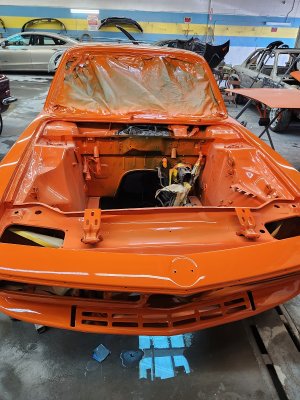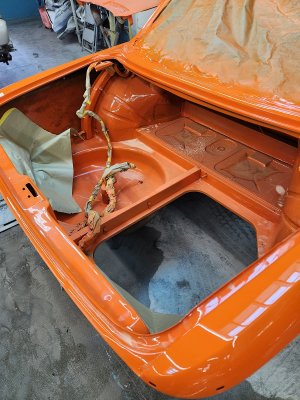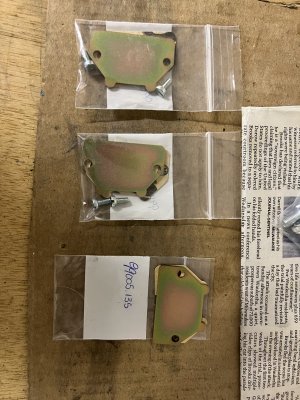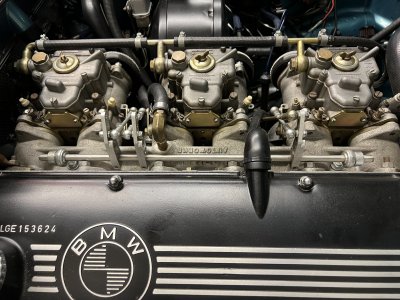hi Chris, what kined of paint you are going to spray on engine bay, I use one step paint only on engine bay and trunk, that will stay shiny alwaysLooking very good Barry!
You are using an out of date browser. It may not display this or other websites correctly.
You should upgrade or use an alternative browser.
You should upgrade or use an alternative browser.
What did you do to your E9 today?
- Thread starter adawil2002
- Start date
Since it was original but dirty I cleaned it thoroughly and shot Chamonix from a spray can!
The engine downtime projects began with leveling and polishing the valve cover. I taped some 100 grit sandpaper onto the granite counter both underneath each sheet and on the edges:

After a few minutes of wet sanding, stopping to check where the high parts are by pressing down on each side to see the rocking pivot point (mine was between the roundel and the vent pipe), and going just long enough to be flush, I finished just as the rig failed:

Now perfectly flat and polished to natural finish (the dark areas are reflections):

Now I just need a working engine
After a few minutes of wet sanding, stopping to check where the high parts are by pressing down on each side to see the rocking pivot point (mine was between the roundel and the vent pipe), and going just long enough to be flush, I finished just as the rig failed:
Now perfectly flat and polished to natural finish (the dark areas are reflections):
Now I just need a working engine
Last edited:
I think the answer is "no" from your description, but just checking if you put any sort of sealant on it or just left it au naturel?
I just use Collinite metal wax every couple of months or so, only takes a few minutes along with my brass overflow tank and has some residual protection against the elements. Once it's clean then maintaining the look is pretty easy.I think the answer is "no" from your description, but just checking if you put any sort of sealant on it or just left it au naturel?
Hi Chris, will you please explain me about the chock blank cover, what dos it do, a you know one of my E9 have a Weber deco 40 I have a problem to start when is cold.Since it was original but dirty I cleaned it thoroughly and shot Chamonix from a spray can!
thank you in advance
Albert
Hello, how is it helping you blank cover on your Weber, one of my E9 have a same setup as yours with 3 Weber deco 40, will you please explain me, I have a problem to start when is cold, thank you in advance.Thanks to Chris Ohmes,I replaced the unneeded choke links on the Weber DCOE 40 carbs with blank covers. I bought them from Pierce Manifolds.
I removed my cold start devices for several reasons. First, I live in a warm climate and my car is always garaged, so the need is not great.
Second, I never let my car sit to warm up, I drive it. It warms up pretty quickly.
My car ran rough until warm either way, so I felt they didn't work well. The devices are primarily an enrichment circuit, so they pump a lot of extra fuel in the car, which seems like a waste.
I also didn't like the complexity of running another linkage/cable to turn them on and off. I often see people who have these devices on their carburetors, but who don't use them because they never got around to installing a "choke" cable.
Finally, especially if they are not connected to a cable or linkage, I felt they were another potential source of vacuum leaks.
Second, I never let my car sit to warm up, I drive it. It warms up pretty quickly.
My car ran rough until warm either way, so I felt they didn't work well. The devices are primarily an enrichment circuit, so they pump a lot of extra fuel in the car, which seems like a waste.
I also didn't like the complexity of running another linkage/cable to turn them on and off. I often see people who have these devices on their carburetors, but who don't use them because they never got around to installing a "choke" cable.
Finally, especially if they are not connected to a cable or linkage, I felt they were another potential source of vacuum leaks.
There is also an internal choke block off kit available, installed under the top covers, which eliminates the possibility of these circuits leaking fuel into the engine and wreaking (and reeking) havoc on driveability. I installed these kits on mine but kept the external devices for show along with a fake choke cable linking the 3 together (I obviously have some ocd issues). Another fix for stopping leaking chokes is to instert a small hex grub screw up into the jet from inside the throat, I did this on a previous set of carbs. I never needed any cold start assistance even when temps were below freezing, a few pumps of the pedal throws enough gas in to start the engine when cold.
Last edited:
Looks like I could use those blank covers and some wire brush cleaning!

Albert - if you don't run your car regularly, fuel will drain from the bowls. This happens quickly with the Webers because they are angled toward the engine. The bowls must have some fuel to start, so if they are dry you have to wait for the starter to cause the pump to fill them before the engine will fire.Hello, how is it helping you blank cover on your Weber, one of my E9 have a same setup as yours with 3 Weber deco 40, will you please explain me, I have a problem to start when is cold, thank you in advance.
I addressed this problem by using a fuel pump controller that fills the bowls when I turn on the key. See here: https://e9coupe.com/forum/threads/adding-a-electric-fuel-pump-suggestions.42221/post-369474
Last edited:
thank you so much Chris, I got that red fuel pump when I read that, it is for Weber, But didn't buy the fuel pump controller, since didn't know what is it for, do I have to install the controller?Albert - if you don't run your car regularly, fuel will drain from the bowls. This happens quickly with the Webers because they are angled toward the engine. The bowls must have some fuel to start, so if they are dry you have to wait for the starter to cause the pump to fill them before the engine will fire.
I addressed this problem by using a fuel pump controller that fills the bowls when I turn on the key. See here: https://e9coupe.com/forum/threads/adding-a-electric-fuel-pump-suggestions.42221/post-369474
thank you again
Albert
Fuel pump controller gives you three benefits:thank you so much Chris, I got that red fuel pump when I read that, it is for Weber, But didn't buy the fuel pump controller, since didn't know what is it for, do I have to install the controller?
thank you again
Albert
1) Easier starting - it fills the bowls in the carburetors when you turn the key, making the engine fire up more quickly
2) Safety - the controller will stop fuel flow if it does not get a signal from the ignition coil that the engine is running. This is applying a more modern technology to make an older car safer.
3) Better electrical circuit - carbureted cars did not have a fuel pump circuit, and installing a separate relay into the circuit creates a more robust electrical connection.
You can wire the fuel pump to go on with the ignition, so you don't need one of these. But I think it is a good idea. I got this idea from @Stevehose. Maybe he can add to this.
You've covered itMaybe he can add to this.
thank you for your time and explanation.Fuel pump controller gives you three benefits:
1) Easier starting - it fills the bowls in the carburetors when you turn the key, making the engine fire up more quickly
2) Safety - the controller will stop fuel flow if it does not get a signal from the ignition coil that the engine is running. This is applying a more modern technology to make an older car safer.
3) Better electrical circuit - carbureted cars did not have a fuel pump circuit, and installing a separate relay into the circuit creates a more robust electrical connection.
You can wire the fuel pump to go on with the ignition, so you don't need one of these. But I think it is a good idea. I got this idea from @Stevehose. Maybe he can add to this.
First "major award" with the E9 at a local car show.
It came with a free sunburn. :>)

It came with a free sunburn. :>)
I knew about floating calipers but floating wheels? That’s next level!




